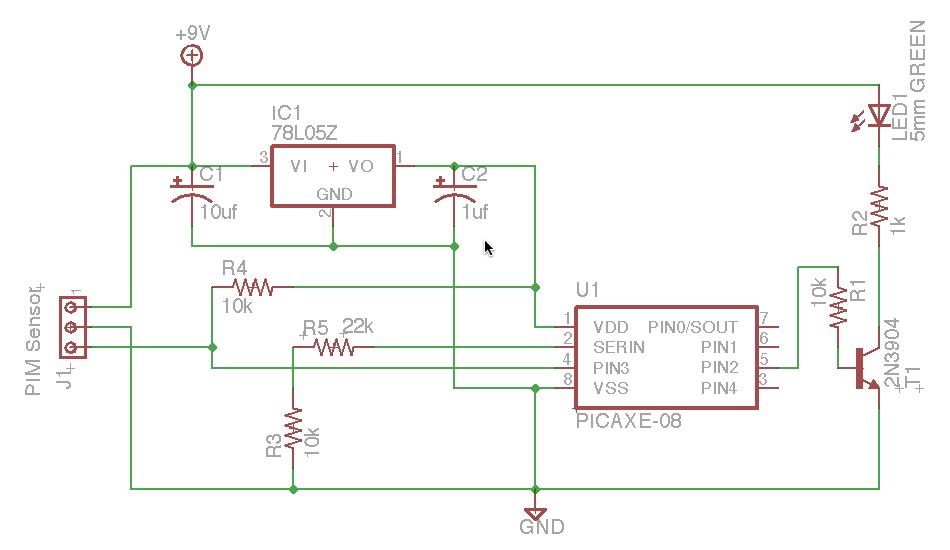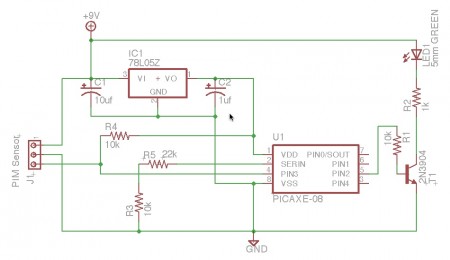My home-brew cat deterrent circuit

A few weeks ago I came across a circuit online on showing how to automatically turn on the heated seats in a G8. The author of the post basically provided all the details on how to accomplish this by building his own device from scratch. He provided a parts list, schematic and the necessary programming (to program the required micro-controller). That project has been added to my list of things to do, but that’s a post for another day. Who knows, at this point I might even look at mktpcb.com and have them create the board for me if I don’t get round to doing it. It was that future project though, which was the inspiration for this project. With a little background out of the way, lets get to it.
I have two cats at my house, Chief and Jumper. They have a bad habit of jumping on the counter top in the kitchen. I need to find a way to keep them off the counter top, especially when I’m not home. Now given my background in electronic circuitry I set off to make a custom device that will accomplish this for me. My fiance and I have discovered that the blender is an excellent tool at scaring the cats enough to make them flee the area. Great! Using the blender and the inspirational project I plan to build a circuit that will automate the blender for me.
What will it take to accomplish this project? I’ll need 3 things:
- Motion sensing capabilities
- A control device
- A blender
The motion sensor is a given. Something needs to keep an eye on the counter top in my absence. After a quick dissection of the blender I figured out that all it will take is a relay that can simulate a button press that can fire up the blender. Great, I have the required input (the sensor) and the output (relay to turn on blender). Now to make a fully automated device, I’ll need something that can control everything by using the sensor and turning on the blender when movement is detected. Enter the micro-controller (along with some associated circuitry. For this project I chose a picaxe micro-controller chip. More specifically the PICAXE-08M. It’s cheap, easy to use and is small and will do everything I need.
So what’s gonna happen? The micro-controller will monitor the output of the motion sensor and when there is movement detected it will turn on a relay which will simulate a button press on the blender. This project is in prototyping phase and I have built a test circuit on a bread board and have drawn out the schematic to share the project.
 This may look scary to beginners, but it’s not that complicated. I built this circuit (picture of the bread board and video in a future post) in one day. Using a 9 volt battery to supply power to an LED (soon to be relay) and the motion sensor and a 5 volt regulator to power the chip (9 volts would fry it) and a few other components I was able to make a prototype device and accompanying schematic. What the picaxe chip essentially does is turn on, wait 30 seconds (gives us enough time to leave the area), and then start monitoring the sensor. As soon as any motion is detected the picaxe will turn on the LED for 3 seconds, then wait 5 seconds (enough time for the cats to leave the area) and then go back to waiting for more movement.
This may look scary to beginners, but it’s not that complicated. I built this circuit (picture of the bread board and video in a future post) in one day. Using a 9 volt battery to supply power to an LED (soon to be relay) and the motion sensor and a 5 volt regulator to power the chip (9 volts would fry it) and a few other components I was able to make a prototype device and accompanying schematic. What the picaxe chip essentially does is turn on, wait 30 seconds (gives us enough time to leave the area), and then start monitoring the sensor. As soon as any motion is detected the picaxe will turn on the LED for 3 seconds, then wait 5 seconds (enough time for the cats to leave the area) and then go back to waiting for more movement.
In the next few days I will post up a pic (and probably video of this in action). The LED will need to be changed out to a relay which will be wired to the blender. Then more testing. If all is successful, I will put it all together by soldering the circuit to a small board and put it in a plastic box enclosure. I may even added the circuitry to run this off the outlet power that the blender uses to eliminate the need for the battery.

0 Comments on “My home-brew cat deterrent circuit”